-
Posts
448 -
Joined
-
Last visited
-
Days Won
1
Content Type
Profiles
Forums
Blogs
Gallery
Events
Store
Posts posted by Richard LaTondre
-
-
This is a great site for Japanese war songs. Some go as far back as the Meiji period:
http://rasiel.web.infoseek.co.jp/en/index.html
It would provide good background for reading a good book:
www.thegoldenkite.com
Richard LaTondre
0 -
Can anyone identify this piece, or the warlord illustrated? It's gilt and enamel, 60mm, with a blank reverse. The detail shot includes the characters below the bust.
Jeff:
Didn't I already ID that medal? Cao Kun Protector of the Constitution medal?
Dick
0 -
I can recommend the book, having recently finished reading it.
Regards
Brian
Thank you Brian.
Dick
0 -
For you folks that are lucky enough to own a "Kindle" Amazon.com has published "The Golden Kite" today. Some of you may find the Chapter on Awards and Decorations of Interest, while others may enjoy the excitement of the longest reconnaisance mission in recorded history.
Regards,
Dick
0 -
5 class. my new collection. it is good condition
Very very nice! Thanks for sharing the great pictures.
0 -
The Auction XV of La Galerie Numismatique closed May 18th and I was fortunate in a low bidding turn out to acquire all three classes of the Royal Order of Cambodia, The Commander's Cross, The Officer's Badge, and the Knights Badge together with a miniature of the same. The Commander's Cross Neck Badge is 95 x 66 mm embellished with diamond specks and has the first model ribbon,
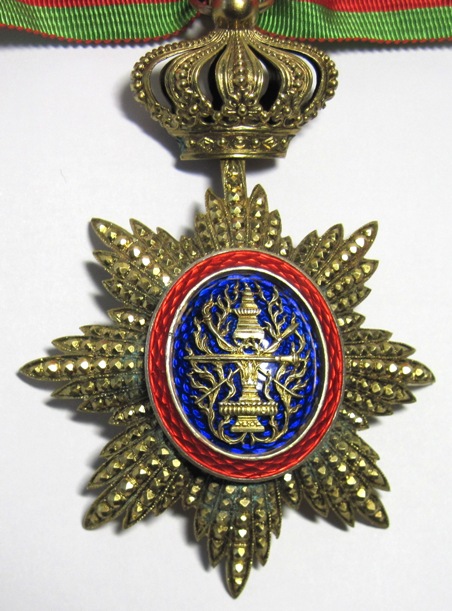 0
0 -
I figure that the Japanese/Manchukuo medals would cost in the neighborhood of US $50,625.00
0 -
Hi Brian,
I'm glad that you did and that is your book!
Best Regards,
Dick
0 -
On page 225 of “The Golden Kite” is a chapter pertaining to the decorations and medals of General Fukushima which consist of the following, listed in no specific order:
Grand Cordon Order of the Golden Kite
Grand Cordon Order of the Rising Sun
Grand Cordon Order of the Sacred Treasure
French Legion of Honor, Officer Rank
Order of the Golden Kite Fourth Class
Belgian Order of Leopold Cross, Fourth Class
Grand Star of Austria
Japanese Order of Merit, Second Order
Order of the Golden Kite, Third Class
Order of the Sacred Treasure, Sixth Class
Order of the Iron Crown with War Wreath
Breast Star, Knight Commander, Order of the Bath
Commander, Order of Albert Star, Saxony
Bavaria, Order of Military Merit, Commander
Prussia, Order of the Red Eagle, Second Class, with Swords
Germany, Order of the Red Eagle, Third Class
Montenegro, Order of Denillo, Third Class, Commander
Japanese Campaign Medals
1894 – 1895 War Medal
1900 War Medal
1904 – 1905 War Medal
1914 -1920 War Medal
Manchukuo National Foundation Merit Medal
Manchukuo National Census Commemorative Medal
Manchukuo National Red Cross Merit Medal
I have since been approached by several individuals/groups that have asked me the estimated cost of reconstructing the Generals Display of Decorations and medals. Of course I have no idea of the cost let alone if it is even possible at the present time.
Fukushima, Yasumasa Portraits of Modern Japanese Historical Figures.htm
0 -
Hi Dick,
Thanks very much. That resource is excellent and new to me.
Cheers!
I forgot to ask you, does the Westmoreland in your email address have anything to do with General Westmoreland?
Dick
0 -
I am working on a research project dedicated to Lieutenant General of Cavalry Tatsuji Ogura, Commanding General of the 127th Infantry Division.
I am having trouble locating information on him and I am hopeful some forum members will be able to add to his narrative, perhaps even a picture.
Thanks in advance,
Mike Constandy
mjc@westmorelandresearch.org
Mike:
Have you tried:
http://www.jacar.go.jp/english/index.html
If he was a military officer he would be there. I just finished a book "The Golden Kite" which contained the exploits of Baron General Yasumasa Fukushima and the above site was invaluable. Hope this helps.
Dick
0 -
Dick:
I think the problem in Chinese medals is that there are so many fakes around that almost every medal is under suspicion to be wrong. I would for sure love to see a picture of the backside here this would be a good reference it one of these medals shows up in the future.
thank you all very much and best regards
a l e x
Hello Alex:
I will try and attach a photo of the backside of the medal for you. The reverse looks better than the obverse.
Best Regards,
Dick
 0
0 -
Thank you very much for your reply, I agree that the medal looks faded out in comparison to the one on OMSA, but this is done (like the one on OMSA) in porous printig on metal which easily fades over the years. The ribbon, hock and medal looks real to me, the back is just broken out. But of course this is just my opinion, I never had one of these medal or saw one in real I only compared the pictures which leads mi conclusion that this is not a fake.
I couldn't find a Picture of the Backside on OMSA or any other website or book do you have on of these medals in your collection Dick?
best regards
a l e x
Alex:
What you say is quite true. The medal could look that way do to exposure over the years but I think some of the gilt wash would have remained. Sory to say I do not have any of Wu Beifu's medals. I wish that I did. However this medal is in the Harry Mohler collection at the Hoover Institution at Stanford University. I can publish the back of the medal if you like.
Best Regards,
Dick
0 -
This appears to be a very poor copy of the Wu Peifu Merit Medal. Wu is the family name and Peifu was his given name. The genuine medal measures 55 x 51 mm in diameter and has a gilt wash. The portrait medallion is usually a separate part of the medal and done in excellent cloisonne. The Back should be sky (powder) blue with a red band on the outside circumference inside of which are two crossed flags in vivid color. I believe I placed a picture of one in the OMSA medal data base.
Dick
0 -
hello
this Wei Pei Fu Award was on ebay last week. I wonder if anyone knows if the backside is blank like on these picture or if this medal is just broken?
best regards
a l e x
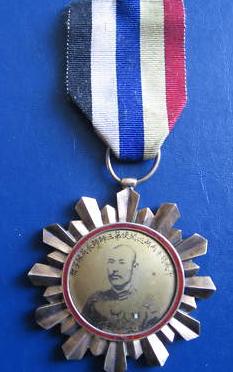
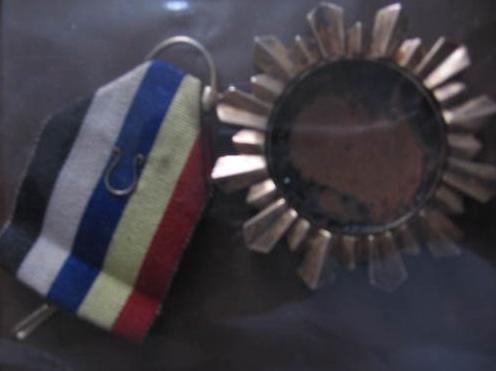 0
0 -
I would agree, However the situation was somewhat more complex because of Emperor Willhem's award of the Third Class Red Eagle to him. They had to give him an award at least of equal grade to that given to him by a foreign government otherwise it could give the impression that Fukushima's mission was really not all that significant. Perhaps that is what the Japanese military intended . . . .to downplay the importance of the mission and not highlight it. Fukushima had previously been awarded the Sixth Class Sacred treasure. The following is taken from the Osaka Shimbun, June 10th 1893:
". . . His left chest is bedazzled with medals, He is wearing the Sixth Class 'zui Ho Sho (Sacred Treasure), awarded by the Emperor himself, the Third Class Order of the Red Eagle awarded by the Emperor of Germany, the Fourth Class Order of Leopold for services rendered in the Crimea, and the Third Class Order of Danilo from Montenegro for services during the Ottoman War." I believe that this was a delicate situation in which the Japanese did not want to appear to be rewarding this man for his reconnaisance mission. It was not considered gentlemanly to engage in spying. Fukushima was eventually awarded the Order of the Sacred Treasure Third Class which was considered a 'six level increase' I have no idea how they arrived at a 'six level increase'
0 -
There is a chapter of the book, The Golden Kite, on (page 225) that covers Fukushima's medals and decorations. It also addresses the Japanese protocols in awarding the Japanese medals.
One of the most sensitive items was: "What type and grade of an award can we give Lieutenant Colonel Fukushima for his successful mission?". This was a very intricate and delicate problem created by the fact that he had already been awarded the Order of the Red Eagle Third Class from the Emperor of Germany. This was a very high award for a field grade officer, let alone a foreigner. In order to at least match that award the Vice Chief-of-Staff, Lieutenant Soroku Kawakami suggested he be awarded the Order of the Rising Sun Second Class.
However, the strict rules for the awarding of medals in Japan during the conservative Meiji military period were very strict. There was no precedence in awarding a 'nine level jump' which apparently would have been the case if Fukushima were to be awarded the Order of the Rising Sun Second Class. But Kawakami tried to slip the recommendation through the approval process. It was approved and passed on to the Minister of the Army, Lieutenant General Iwao Oyama for final approval. His deputy, Major General Kodama disapproved the recommendation.
Richard LaTondre
0 -
Thank You!
0 -
Thanks Brian. I tried to upload the books jacket (275 kb) bu the GMIC website would not allow it. I hear that you can pay by PayPal even though you are not a member of PayPal. You remit the funds to "USMCGungHo@aol.com". The book retails for $19.95. I would like to offer it to GMIC folks for $15.00 which includes domestic shipping by priority (2 to 3 days) mail. The book consists of 318 pages with index, illustrations, and gazeteer. The Library of Congress number is TXu00113660905 2007-07-17, The ISBN-13: is 978-0-9816493-0-6. I will have a website by next week which should help.
Richard
0 -
Well. . . . after nine years its finally finished! This week marks the arrival of my book about the longest reconnaisance mission in recorded history.
On February 11th 1892, Major Yasumasa Fukushima, a military attache stationed at the Japanese legation in Berlin, departs on a journey of 9,000 miles, 14,000 km, on horseback, alone, across two continents and nine countries to arrive in Vladivostok 488 days later. While outwardly doing this as a wager at the Officer's Club over several drinks, It was probably, in fact, the longest reconnaisance missions in recorded history. This event was never published in English and most of the records of this epic mission were destroyed by the Japanese government at the close of World War II. The book contains the daily journal entries he made during the complete journey. Was the Trans-Siberian Railway that great of a threat to Japan? He followed the then undergoing construction of the trans-Siberian Railway as well as the telegraph infrastructure enroute. Japan was aware that this railroad, when completed, would be like a sword pointing to Japan's soft underbelly. Russian expansion eastword would allow massive numbers of Russian troops to be moved to the Pacific and the Sea of Japan in a matter of days. His daily diary entries tell of this perilous journey as he meets Kings, Czars and War Lords. The brutal weather ranges from below zero Siberia to the intense heat of the Gobi dessert. He even meets the founder of a major Silicon Valley electronics conglomerate.Fukushima was also the founder of the Japanese Secret Service Kempei Tai. He attended the U.S. Centennial in 1876. He was one of the senior allied officers during the Boxer Rebellion, commanding over 18,000 Imperial Japanese Troops at T'ienChing. You might say that he, not Charlton Heston and the U.S. Marines, saved the day.
Thanks for reading this and the best regards to all,
Richard B. La Tondre
0 -
Another Striped Tiger on eBay. Wouls you buy this one?
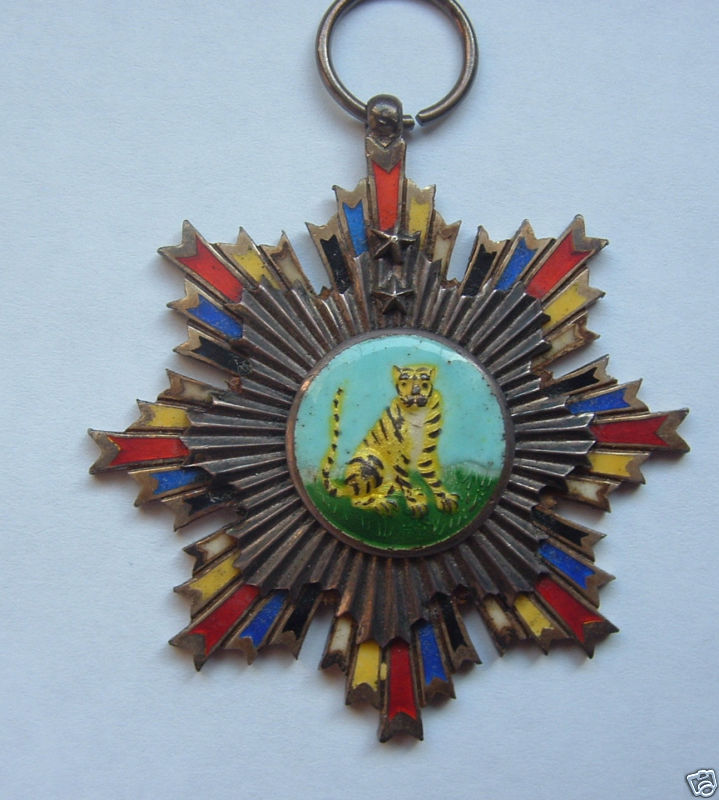 0
0 -
I know that Mount Kumgang (Kumgangsan) has very deep, almost mythical significance to Koreans, both North and South, but don't know the story behind it. Can anyone provide more info?
Hugh
I believe that it is an area of high spiritual signifigance. It is known as the Diamond mountain and the home of Buddha. Some say that it has 24,000 peaks and from them have occured 24,00 miracles. The name also changes with the four seasons.
0 -
You may want to consider this as a "filler" the price is right at $2.95
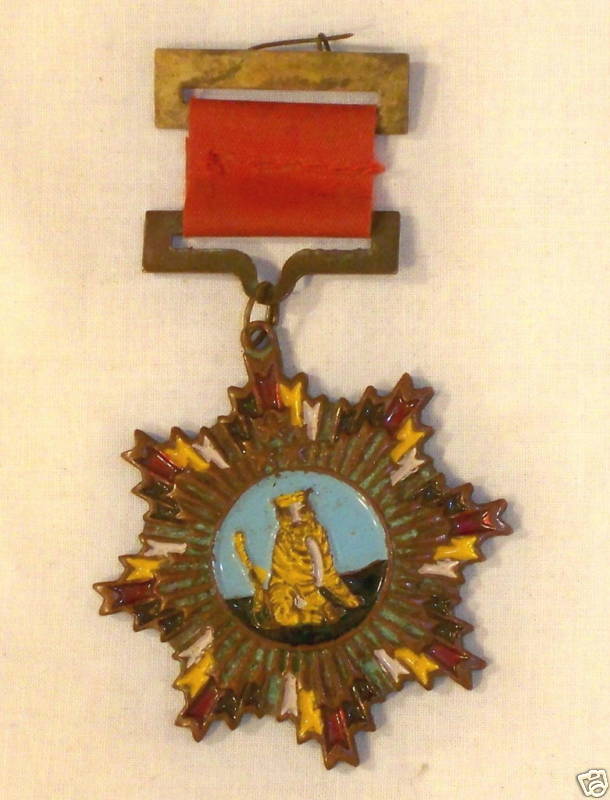 0
0 -
Looking at the small red tag inside the box . . . . does this say 2nd Class, 2nd Grade?
Thanks.
Richard
0



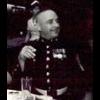
German and Japanese War songs
in Germany: Imperial: Rick (Research) Lundstrom Forum for Documentation and Photographs
Posted
Though it is in Japanese there are some great German War songs (martial/patriotic) in with the Japanese songs:
http://rasiel.web.infoseek.co.jp/en/index.html
Richard LaTondre